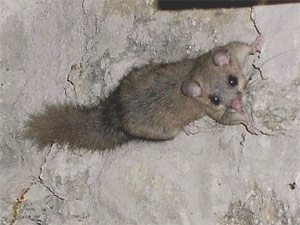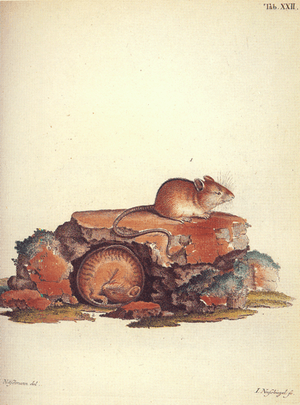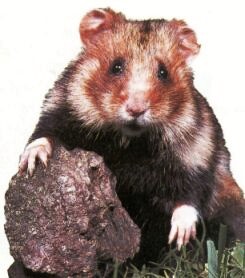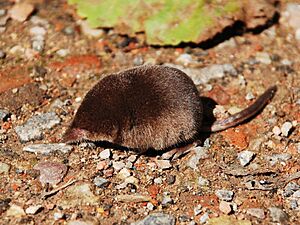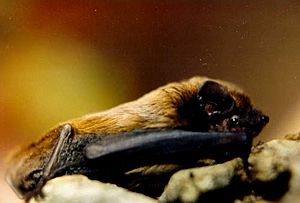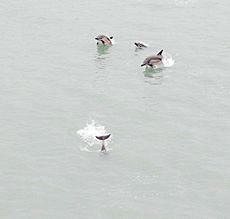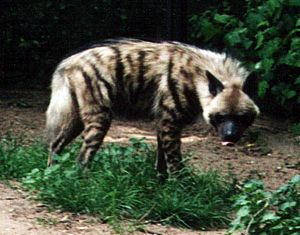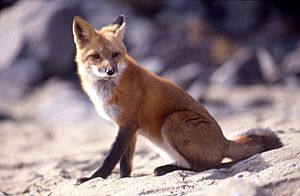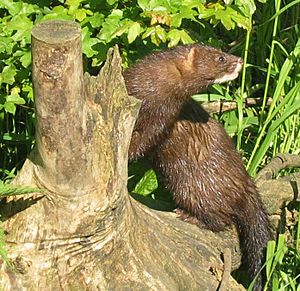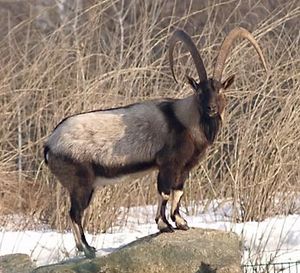List of mammals of Georgia (country) facts for kids
There are 80 mammal species in Georgia, of which one is critically endangered, two are endangered, ten are vulnerable, and two are near threatened. All mammals in Georgia are in subclass Theria and infraclass Eutheria, being placental mammals.
The following tags are used to highlight each species' conservation status as assessed by the International Union for Conservation of Nature:
| EX | Extinct | No reasonable doubt that the last individual has died. |
| EW | Extinct in the wild | Known only to survive in captivity or as a naturalized populations well outside its previous range. |
| CR | Critically endangered | The species is in imminent risk of extinction in the wild. |
| EN | Endangered | The species is facing an extremely high risk of extinction in the wild. |
| VU | Vulnerable | The species is facing a high risk of extinction in the wild. |
| NT | Near threatened | The species does not meet any of the criteria that would categorise it as risking extinction but it is likely to do so in the future. |
| LC | Least concern | There are no current identifiable risks to the species. |
| DD | Data deficient | There is inadequate information to make an assessment of the risks to this species. |
Contents
- Order: Rodentia (rodents)
- Order: Lagomorpha (lagomorphs)
- Order: Erinaceomorpha (hedgehogs and gymnures)
- Order: Soricomorpha (shrews, moles, and solenodons)
- Order: Chiroptera (bats)
- Order: Cetacea (whales)
- Order: Carnivora (carnivorans)
- Order: Artiodactyla (even-toed ungulates)
- Locally extinct
- See also
Order: Rodentia (rodents)
Rodents make up the largest order of mammals, with over 40% of mammalian species. They have two incisors in the upper and lower jaw which grow continually and must be kept short by gnawing. Most rodents are small though the capybara can weigh up to 45 kg (99 lb).
- Suborder: Hystricognathi
- Family: Hystricidae (Old World porcupines)
- Genus: Hystrix
- Indian porcupine, H. indica
- Genus: Hystrix
- Family: Hystricidae (Old World porcupines)
- Suborder: Sciurognathi
- Family: Sciuridae (squirrels)
- Subfamily: Sciurinae
- Tribe: Sciurini
- Genus: Sciurus
- Caucasian squirrel, S. anomalus
- Genus: Sciurus
- Tribe: Sciurini
- Subfamily: Xerinae
- Tribe: Marmotini
- Genus: Spermophilus
- Caucasian mountain ground squirrel, S. musicus
- Little ground squirrel, Spermophilus pygmaeus
- Genus: Spermophilus
- Tribe: Marmotini
- Subfamily: Sciurinae
- Family: Gliridae (dormice)
- Subfamily: Leithiinae
- Genus: Dryomys
- Forest dormouse, Dryomys nitedula
- Genus: Dryomys
- Subfamily: Glirinae
- Genus: Glis
- European edible dormouse, Glis glis
- Genus: Glis
- Subfamily: Leithiinae
- Family: Dipodidae (jerboas)
- Subfamily: Allactaginae
- Genus: Allactaga
- Small five-toed jerboa, Allactaga elater
- Genus: Allactaga
- Subfamily: Sicistinae
- Genus: Sicista
- Northern birch mouse, Sicista betulina
- Kazbeg birch mouse, Sicista kazbegica DD
- Genus: Sicista
- Subfamily: Allactaginae
- Family: Spalacidae
- Subfamily: Spalacinae
- Genus: Nannospalax
- Nehring's blind mole-rat, Nannospalax nehringi
- Genus: Nannospalax
- Subfamily: Spalacinae
- Family: Cricetidae
- Subfamily: Cricetinae
- Genus: Cricetus
- European hamster, C. cricetus presence uncertain
- Genus: Mesocricetus
- Turkish hamster, Mesocricetus brandti
- Genus: Cricetus
- Subfamily: Arvicolinae
- Genus: Chionomys
- Caucasian snow vole, Chionomys gud
- Snow vole, Chionomys nivalis
- Robert's snow vole, Chionomys roberti
- Genus: Ellobius
- Transcaucasian mole vole, Ellobius lutescens
- Genus: Microtus
- Altai vole, Microtus obscurus
- Genus: Prometheomys
- Long-clawed mole vole, Prometheomys schaposchnikowi
- Genus: Chionomys
- Subfamily: Cricetinae
- Family: Muridae (mice, rats, voles, gerbils, hamsters, etc.)
- Subfamily: Murinae
- Genus: Apodemus
- Striped field mouse, Apodemus agrarius
- Yellow-breasted field mouse, Apodemus fulvipectus
- Broad-toothed field mouse, Apodemus mystacinus
- Black Sea field mouse, Apodemus ponticus
- Ural field mouse, Apodemus uralensis
- Genus: Micromys
- Eurasian harvest mouse, Micromys minutus
- Genus: Rattus
- Brown rat, R. norvegicus introduced
- Genus: Apodemus
- Subfamily: Murinae
- Family: Sciuridae (squirrels)
Order: Lagomorpha (lagomorphs)
The lagomorphs comprise two families, Leporidae (hares and rabbits), and Ochotonidae (pikas). Though they can resemble rodents, and were classified as a superfamily in that order until the early 20th century, they have since been considered a separate order. They differ from rodents in a number of physical characteristics, such as having four incisors in the upper jaw rather than two.
- Family: Leporidae
- Genus: Lepus
- European hare, L. europaeus
- Genus: Lepus
Order: Erinaceomorpha (hedgehogs and gymnures)
The order Erinaceomorpha contains a single family, Erinaceidae, which comprise the hedgehogs and gymnures. The hedgehogs are easily recognised by their spines while gymnures look more like large rats.
- Family: Erinaceidae (hedgehogs)
- Subfamily: Erinaceinae
- Genus: Erinaceus
- Southern white-breasted hedgehog, E. concolor
- Genus: Erinaceus
- Subfamily: Erinaceinae
Order: Soricomorpha (shrews, moles, and solenodons)
The Soricomorpha are insectivorous mammals. The shrews and solenodons resemble mice while the moles are stout-bodied burrowers.
- Family: Soricidae (shrews)
- Subfamily: Crocidurinae
- Genus: Crocidura
- Bicolored shrew, C. leucodon
- Lesser white-toothed shrew, C. suaveolens
- Genus: Suncus
- Etruscan shrew, Suncus etruscus LC
- Genus: Crocidura
- Subfamily: Soricinae
- Subfamily: Crocidurinae
Order: Chiroptera (bats)
The bats' most distinguishing feature is that their forelimbs are developed as wings, making them the only mammals capable of flight. Bat species account for about 20% of all mammals.
- Family: Vespertilionidae
- Subfamily: Myotinae
- Genus: Myotis
- Bechstein's bat, M. bechsteini
- Lesser mouse-eared bat, M. blythii
- Geoffroy's bat, M. emarginatus
- Natterer's bat, M. nattereri
- Genus: Myotis
- Subfamily: Vespertilioninae
- Genus: Barbastella
- Western barbastelle, B. barbastellus
- Asian barbastelle, B. leucomelas LC
- Genus: Eptesicus
- Northern bat, E. nilssoni LC
- Genus: Hypsugo
- Savi's pipistrelle, H. savii
- Genus: Nyctalus
- Greater noctule bat, N. lasiopterus
- Lesser noctule, N. leisleri
- Genus: Pipistrellus
- Kuhl's pipistrelle, P. kuhlii LC
- Nathusius' pipistrelle, P. nathusii
- Common pipistrelle, P. pipistrellus LC
- Genus: Plecotus
- Brown long-eared bat, P. auritus
- Grey long-eared bat, P. austriacus LC
- Genus: Barbastella
- Subfamily: Miniopterinae
- Genus: Miniopterus
- Common bent-wing bat, M. schreibersii
- Genus: Miniopterus
- Subfamily: Myotinae
- Family: Rhinolophidae
- Subfamily: Rhinolophinae
- Genus: Rhinolophus
- Mediterranean horseshoe bat, R. euryale
- Greater horseshoe bat, R. ferrumequinum
- Lesser horseshoe bat, R. hipposideros
- Mehely's horseshoe bat, R. mehelyi
- Genus: Rhinolophus
- Subfamily: Rhinolophinae
Order: Cetacea (whales)
The order Cetacea includes whales, dolphins and porpoises. They are the mammals most fully adapted to aquatic life with a spindle-shaped nearly hairless body, protected by a thick layer of blubber, and forelimbs and tail modified to provide propulsion underwater.
- Suborder: Mysticeti
- Family: Balaenopteridae (rorquals)
- Genus: Balaenoptera
- Common minke whale, Balaenoptera acutorostrata LC (vagrant)
- Genus: Balaenoptera
- Family: Balaenopteridae (rorquals)
- Suborder: Odontoceti
- Superfamily: Platanistoidea
- Family: Phocoenidae
- Genus: Phocoena
- Harbour porpoise, Phocoena phocoena VU
- Genus: Phocoena
- Family: Delphinidae (marine dolphins)
- Genus: Delphinus
- Short-beaked common dolphin, Delphinus delphis
- Genus: Tursiops
- Common bottlenose dolphin, Tursiops truncatus DD
- Genus: Delphinus
- Family: Phocoenidae
- Superfamily: Platanistoidea
Order: Carnivora (carnivorans)
There are over 260 species of carnivorans, the majority of which feed primarily on meat. They have a characteristic skull shape and dentition.
- Suborder: Feliformia
- Family: Felidae (cats)
- Subfamily: Felinae
- Genus: Felis
- Jungle cat, F. chaus
- European wildcat, F. silvestris
- Caucasian wildcat, F. s. caucasica
- Genus: Lynx
- Eurasian lynx, L. lynx
- Caucasian lynx, L. l. dinniki
- Eurasian lynx, L. lynx
- Genus: Felis
- Subfamily: Pantherinae
- Subfamily: Felinae
- Family: Hyaenidae (hyaenas)
- Genus: Hyaena
- Striped hyena, H. hyaena
- Genus: Hyaena
- Family: Felidae (cats)
- Suborder: Caniformia
- Family: Canidae (dogs, foxes)
- Genus: Canis
- Golden jackal, C. aureus
- European jackal, C. a. moreoticus
- Gray wolf, C. lupus
- Steppe wolf, C. l. campestris
- Golden jackal, C. aureus
- Genus: Vulpes
- Red fox, V. vulpes
- Genus: Canis
- Family: Ursidae (bears)
- Genus: Ursus
- Brown bear, U. arctos
- Genus: Ursus
- Family: Procyonidae
- Genus: Procyon
- Common raccoon, P. lotor introduced
- Genus: Procyon
- Family: Mustelidae (mustelids)
- Genus: Lutra
- Eurasian otter, L. lutra
- Genus: Martes
- Beech marten, M. foina
- European pine marten, M. martes
- Genus: Meles
- Caucasian badger, M. canescens
- Genus: Mustela
- Stoat, M. erminea
- Steppe polecat, M. eversmannii
- Least weasel, M. nivalis
- Genus: Vormela
- Marbled polecat, V. peregusna
- Genus: Lutra
- Family: Canidae (dogs, foxes)
Order: Artiodactyla (even-toed ungulates)
The even-toed ungulates are ungulates whose weight is borne about equally by the third and fourth toes, rather than mostly or entirely by the third as in perissodactyls. There are about 220 artiodactyl species, including many that are of great economic importance to humans.
- Family: Bovidae (cattle, antelope, sheep, goats)
- Subfamily: Antilopinae
- Genus: Gazella
- Goitered gazelle, G. subgutturosa reintroduced
- Genus: Gazella
- Subfamily: Caprinae
- Genus: Capra
- Wild goat, C. aegagrus
- West Caucasian tur, C. caucasica
- East Caucasian tur, C. cylindricornis
- Genus: Rupicapra
- Chamois, R. rupicapra
- Genus: Capra
- Subfamily: Antilopinae
- Family: Cervidae (deer)
- Family: Suidae (pigs)
Locally extinct
The following species are locally extinct in the country:
- Asiatic cheetah, Acinonyx jubatus
- Moose, Alces alces
- Caucasian wisent, Bison bonanus
- Wild horse, Equus ferus
- Onager, Equus hemionus
- Mediterranean monk seal, Monachus monachus
- European mink, Mustela lutreola
- Northern lion, Panthera leo
- Caspian tiger, Panthera tigris
See also
- List of chordate orders
- Lists of mammals by region
- Mammal classification


